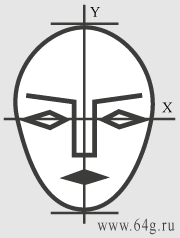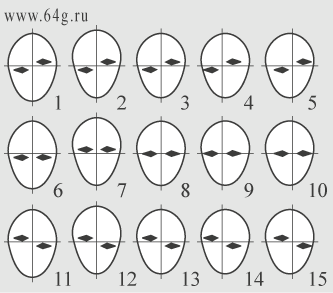-
-
Human facial traits or lineaments in full-face in a context of physiognomy mean
potential psychological features of personality, but also in frontal
perspectives of faces it is possible to see physiognomic projections of brain
hemispheres, that allows to identify mental or psychic functions in a context of
Jungian analytical psychology, and also in socionics and Brigs-Majers type indicator.
Vertical axis of facial symmetry in full-face corresponds with shapes of nose,
and horizontal axis of facial symmetry is connected with geometrical sizes of a
face from chin to forehead top, that is shown on the chart.
 |
Vertical axis of symmetry Y corresponds with the
central line of nose bridge which determines proportions of geometrical
sizes for right and left halves of a face. Horizontal axis of symmetry X is on equal removal from a chin and forehead top, that determines geometrical proportions between top and bottom facial halves. |
Right half of a face is projection of the left brain hemisphere which
corresponds with introversion, namely geometrical sizes of the right facial half
are physiognomic parameters according to which it is possible to identify degree
of introversion in human personality.
Left half of a face is projection of the right brain hemisphere which
corresponds with extraversion, namely geometrical sizes of this facial half
specify degree of personal extraversion.
Top facial half corresponds with rational mental functions of a brain,
namely according to this size it is possible to identify rational psychological
features of personality.
Bottom facial half corresponds with irrational mental functions of a
brain, namely this geometrical size allows to identify irrational psychological
features of people.
Comparison of geometrical shapes of a human face with hemispheres of a brain
allows to identify psychological parameters of personality in a context of
Jungian analytical psychology or in socionics and Brigs-Majers type indicator,
and consequently such method of facial analysis is analytical physiognomy.
Look information about analytical physiognomy
and interrelations of mental functions of a
brain with features of a human face in other sections of this website.
According to two axes of symmetry in faces of people it is possible to identify
fifteen psychological types of personality, that is shown in the table.
 |
Symbolical drawings of faces in the table have
following physiognomic parameters. First vertical row at the left - bottom half of a face is more than top half - irrationality. Second vertical row at the left - top facial half is more than bottom half - rationality. Third central, and also fourth and fifth vertical rows on the right - top and bottom halves of a face have equal sizes - interrationality. Third central, and also first and second vertical rows at the left - right and left halves of a face have equal sizes - attributes of equaverted types. Fourth vertical row on the right - right facial half is less than left half - attributes of extraverted types. Fifth vertical row on the right - left facial half is less than right half - attributes of introverted types. |
-
Top horizontal row - left eye above right - extraverted types.
Middle horizontal row - eyes have equal height - equaverted types.
Bottom horizontal row - right eye above left - introverted types.
Psychological meanings of the shown types of human faces in a context of
analytical physiognomy are the following.
First type of a face.
Irrational extraversion - greater bottom facial half - significant left eye.
Second facial type.
Rational extraversion - greater top half of a face - significant left eye.
Third type of a face.
Interrational extraversion with attributes of equaversion - symmetric facial
halves - significant left eye.
Fourth facial type.
Interrational extraversion - symmetric vertical halves of a face - significant
left eye and greater left facial half.
Fifth type of a face.
Interrational extraversion with attributes of introversion - symmetric vertical
facial halves - significant left eye and greater right half of a face.
Fifth type has mutually exclusive attributes of extraversion with
introversion, and consequently this variant of physiognomic parameters cannot
exist in faces of people.
Sixth facial type.
Irrational equaversion - greater bottom half of a face- symmetry of eyes.
Seventh type of a face.
Rational equaversion - greater top facial half - symmetry of eyes.
Eighth facial type.
Interrational equaversion - symmetric halves of a face and symmetry of eyes.
Ninth type of a face.
Interrational equaversion with attributes of extraversion - symmetric vertical
facial halves - symmetry of eyes - greater left half of a face.
Tenth facial type.
Interrational equaversion with attributes of introversion - symmetry of vertical
facial halves - symmetry of eyes - greater right half of a face.
Eleventh type of a face.
Irrational introversion - greater bottom facial half - significant right eye.
Twelfth facial type.
Rational introversion - greater top half of a face - significant right eye.
Thirteenth type of a face.
Interrational introversion with attributes of equaversion - symmetric halves of
a face - significant right eye.
Fourteenth facial type.
Interrational introversion with attributes of extraversion - symmetric vertical
facial halves - significant right eye and greater left half of a face.
Fourteenth type has mutually exclusive attributes of introversion with
extraversion, and consequently this variant of physiognomic shapes does not
exist in human faces.
Fifteenth type of a face.
Interrational introversion - symmetric vertical facial halves - significant
right eye and greater right half of a face.
According to the listed meanings of physiognomic parameters of human faces, and
according to drawings in the table it is possible to identify psychological
types of personality in a context of analytical physiognomy. Namely positions of
eyes concerning axes of facial symmetry can be considered as additional formal
parameters of 64 psychological types which are shown on pages of this website in
gallery of section with the name:
the right and left face.
Following page shows positions of eyebrows and mouth concerning axes of facial symmetry, that in view of analytical physiognomy allows to identify mental functions of brain hemispheres.